- Home
- Robert J. Sawyer
Hybrids Page 6
Hybrids Read online
Page 6
“Do you know anything about psychology, Ponter?” asked Veronica, her hands clasped behind her narrow back.
“Some,” Ponter said. “I studied it when I was learning about computer science at the Academy. It was-what would you call it?-something I had to study along with artificial intelligence.”
“A co-requisite,” supplied Mary.
“In every freshman psych course,” said Veronica, “humans here learn about B. F. Skinner.”
Mary nodded; she’d taken an introductory psychology course herself. “Behaviorism, right?”
“Right,” said Veronica. “Operant conditioning; reinforcement and punishment.”
“Like training dogs,” said Ponter.
“Just so,” said Veronica. She stopped pacing. “Now, please, Mary, don’t say a word. I want to hear Ponter’s response to this without any influence from you.”
Mary nodded.
“All right, Ponter,” said Veronica. “Do you remember your psych studies?”
“No, not really.”
The young redhead looked disappointed.
“But I do,” said Hak, through its external speaker, in its synthesized male voice. “Or, more precisely, I have the equivalent of a textbook on psychology loaded into my memory. It helps me to advise Ponter when he is making an idiot of himself.”
Ponter grinned sheepishly.
“Excellent,” said Veronica. “Okay, here’s the question: what’s the best way to ingrain a behavior into a person? Not something you want to extinguish, but something you want to foster.”
“Reward,” said Hak.
“Reward, yes! But what kind of reward?”
“Consistent.”
Veronica looked as though something incredibly significant had just transpired. “Consistent,” she repeated, as if it were the key to everything. “Are you sure? Are you absolutely sure?”
“Yes,” said Hak, sounding as puzzled as he ever got.
“It’s not here, you know,” said Veronica. “Consistent reward isnot the best way to ingrain a behavior.”
Mary frowned. She’d doubtless known the right answer at one time, but couldn’t dredge it up after all these years. Fortunately, Ponter himself asked the question Veronica was waiting for. “Well, then, whatis the best way to ingrain a behavior among your kind of humans?”
“Intermittentreward,” said Veronica triumphantly.
Ponter frowned. “You mean sometimes rewarding the desired behavior, and sometimes not?”
“Just so!” said Veronica. “That’s precisely right!”
“But that does not make sense,” said Ponter.
“Of course not,” agreed Veronica, grinning widely. “It’s one of the strangest things aboutHomo sapiens psychology. But it’s absolutely true. The classic example is gambling: if we always win at a game, the game becomes boring for us. But if we only win some of the time, it can become addictive. Or it’s like kids whining to their parents: ‘Buy me this toy!’ ‘Let me stay up late!’ ‘Drive me to the mall.’ It’s the behavior parents hate the most from their kids, but the kids can’t help themselves-not because the whiningalways works, but because itsometimes works. The unpredictability makes it irresistible for us.”
“That is crazy,” said Ponter.
“Not here,” said Veronica. “Not by definition: the behavior of the majority is never crazy.”
“But...but surely it is simply irritating not to have a predictable outcome.”
“You’d think,” agreed Veronica amiably. “But, again, it’s not-not for us.”
Mary found herself fascinated. “You’re obviously on to something, Veronica. What is it?”
“Everything we’re doing here at the Neuroscience Research Group has been about explaining the classic religious experience. But there are lots of believers who’ve never had a religious experience, and yet they still believe. That’s the hole in our work, the missing piece in a comprehensive explanation of whyHomo sapiens believe in God. But this is the answer-do you see? It’s this psychology of reinforcement-this bit of the way our brains are programmed-that makes us susceptible to belief in God. If there really was a God, a rational species would expect rational, predictable behavior from him. But we don’t get that. Sometimes, it seems as though God protects certain people, and at other times, he’ll let a nun fall down an open elevator shaft. There’s no rhyme or reason to it, and so we say-“
Mary was nodding, and she finished the thought for Veronica. “We say, ‘The Lord works in mysterious ways.’ “
“Just so!” crowed Veronica. “Prayers aren’t always answered, but people go right on praying. But Ponter’s people aren’t wired like that.” She turned to the Neanderthal. “Are you?”
“No,” said Ponter. “I do not need Hak to tell me that this is not the way we behave. If the result is not predictable-if a pattern cannot be discerned-we discard the behavior as pointless.”
“Butwe don’t,” said Veronica, rubbing her hands together. Mary could see she had the same “Cover ofScience , here I come!” expression Mary herself had worn years ago, when she’d succeeded in extracting DNA from the Neanderthal type specimen in Germany. Veronica beamed at Ponter, then at Mary. “Even if there is no pattern, we convince ourselves that there’s some underlying logic to it all. That’s why we don’t just make up stories about gods; we actuallybelieve them.”
The religious Mary had shifted entirely to the background; this was making the scientist in her have its own peak experience. “Are you sure about this, Veronica? Because if you are-“
“Oh, I am; I am. There’s a famous experiment-I’ll e-mail you the citation. It had two groups of people playing a game on a grid, the rules of which hadn’t been explained to the players. All they knew in advance was they’d get points for good moves and no points for bad moves. Well, for one set of players, points were given for successfully marking every other space in the lower-right corner of the grid-and, of course, after enough turns, the players easily figured that out, and could win the game every time. But the second set of players were rewarded pointsrandomly: whether they got points or not had no relation to what moves they made. But those playersalso came up with rules that they said governed the game, and they were convinced that by following those rules, they were likely to do better.”
“Really?” said Ponter. “I would simply lose interest in the game.”
“No doubt you would,” said Veronica, smiling broadly. “But we would find it fascinating.”
“Or irritating,” said Mary.
“Irritating, yes! Meaning it would bug us-because we just can’t accept that there’s no underlying design to things.” Veronica looked at Ponter. “Can I try another little test? Again, Mary, if you don’t mind, please don’t say anything. Ponter, do you know what I mean when I talk about flipping a coin?”
Ponter didn’t, so Veronica demonstrated with a loonie she fished from a pocket of her lab coat. When Ponter nodded that he understood, the skinny redhead went on. “All right, if I flip this coin twenty times, and all twenty times it happens to come up heads, what are the chances it will come up heads again on the twenty-first try?”
Ponter didn’t hesitate. “One-to-one.”
“Just so! Or to put it the way we would, fifty-fifty, right? An even chance.”
Ponter nodded.
“Now, Mary, I’m sure you know that Ponter is absolutely right: it doesn’t matter how many times heads has come up in succession before the current flip, assuming the coin isn’t unbalanced. The odds that the next flip will be heads are always fifty-fifty. But when I ask first-year psych students this question, most of them think the odds must be astronomically against getting yet another heads. At some fundamental level, our brains are wired to impute motivation to random events.That’s why even those who don’t ever have the kind of experience we just manufactured for you, Mary, still see God’s handiwork in what’s really just randomness.”
Chapter Nine
“It was that questing spirit th
at moved some of us to march thousands of miles across the Bering Land Bridge, which linked Siberia and Alaska during the Ice Age...”
Mary wanted to take a quick look at the Laurentian University bookstore before they headed down to the portal. She’d forgotten to bring any books from her home in Richmond Hill, and of course wouldn’t be able to find reading matter for herself in the Neanderthal universe.
Also, truth be told, Mary wanted a few minutes alone to try to digest what had transpired in Veronica Shannon’s lab, so she excused herself, leaving Ponter with Veronica, and was now heading down “the bowling alley”-the long, narrow, glass-walled corridor that connected Laurentian’s Classroom Building and the Great Hall. Coming toward her was an attractive young black woman. Mary had never been good about remembering faces, but she saw in the expression of the other woman a brief reaction of recognition, and then, almost at once, that reaction masked.
Mary had more or less gotten used to that. She’d been in the media a lot since early August when she’d confirmed the man who had been found half-drowned in the Sudbury Neutrino Observatory was a Neanderthal. She continued walking along, then it hit her-
“Keisha!” Mary said, rotating on her heel, the black woman now having passed her.
Keisha turned around and smiled. “Hello, Mary,” she said.
“I almost didn’t recognize you,” said Mary.
Keisha looked a bit guilty. “Idid recognize you.” She lowered her voice. “But we’re not supposed to acknowledge anyone we met at the Centre, unless they acknowledge us first. That’s part of ensuring privacy...”
Mary nodded. “The Centre” was the Laurentian University Rape Crisis Centre, where Mary had gone for counseling after what had happened at York.
“How are you doing, Mary?” asked Keisha.
Off in the distance there was a Tim Hortons coffee-anddonuts stand. “Do you have a moment?” asked Mary. “I’d love to buy you a coffee.”
Keisha looked at her watch. “Sure. Or-or do you want to go upstairs, to, you know, the Centre?”
But Mary shook her head. “No. No, that’s not necessary.” Still, she was silent as they walked the dozens of meters to the Tim Hortons, contemplating Keisha’s question. Howwas she doing?
The Tim Hortons chain was one of the few places Mary could sometimes get her favorite brew-coffee with chocolate milk-since they often had open cartons of both chocolate and white milk. She asked for it, and received it. For her part, Keisha requested an apple juice, and Mary paid for them both. They sat at one of the two small tables flush with the corridor’s glass wall-mostly, people got their coffee here and ran off somewhere else.
“I want to thank you,” said Mary. “You were so kind to me, back then...”
Keisha had a small jeweled stud in her nose. She tipped her head down, and the jewel caught the sunlight, flashing. “That’s what we’re here for.”
Mary nodded. “You asked how I was doing,” she said. “There’s a man in my life now.”
Keisha smiled. “Ponter Boddit,” she said. “I read all about it inPeople .”
Mary felt her heart jump. “Peopledid an article about us?”
The younger woman nodded. “Last week. Nice photo of you and Ponter at the UN.”
Good grief, thought Mary. “Well, he’s been very good to me.”
“Is he going to take up that offer to pose inPlaygirl ?”
Mary smiled. She’d almost forgotten about that; the offer had come during Ponter’s first visit, when they were quarantined. Part of Mary would love to show off the physique of her man to all the bimbo girls she’d endured in high school, the ones who had dated the football players, every one of whom would look scrawny in comparison to Ponter. And another part of her was tickled at the notion that there was no way Colm could resist taking a peek at a newsstand, wondering what this Neanderthal had that he didn’t...
“I don’t know,” said Mary. “Ponter laughed when the invitation came, and hasn’t mentioned it since.”
“Well, if he ever does,” said Keisha, smiling, “I want an autographed copy.”
“No problem,” said Mary. And she realized she meant it. She would never be over her rape-nor, she suspected, would Keisha ever be over her own-but the fact that they could joke about a man posing nude for the enjoyment of women meant that they’d both come a long way.
“You asked how I’m doing,” said Mary. She paused. “Better,” she said with a smile, reaching out and patting the back of Keisha’s hand. “Better every day.”
Once they’d finished their drinks, Mary hurried off to the bookstore, quickly bought four paperbacks, and then hustled back to room C002B to collect Ponter. They headed up to the ground floor, then out into the parking lot. It was a crisp fall day, and here, four hundred kilometers north of Toronto, the leaves had mostly turned.
“Dran!” exclaimed Ponter, and “Astonishment!” translated Hak, through his external speaker.
“What?” said Mary.
“What isthat? “ said the Neanderthal, pointing.
Mary looked ahead, trying to fathom what had caught Ponter’s eye, then she burst out laughing. “It’s a dog,” she said.
“My Pabo is a dog!” declared Ponter. “And I have encountered other doglike creatures here. But this! This is like nothing I have ever seen before.” The dog and its owner were coming toward them. Ponter bent down, hands on knees, to examine the small animal, at the end of a leather leash being held by an attractive young white woman. “It looks like a sausage!” declared Ponter.
“It’s a dachshund,” said the woman, sounding miffed. She was doing a great job, Mary thought, of being unflustered in the presence of what she must know was a Neanderthal.
“Is it-“ began Ponter. “Forgive me, is it a birth defect?”
The woman sounded even more put out. “No, he’s supposed to be like that.”
“But his legs! His ears! His body!” Ponter rose and shook his head. “A dog is a hunter,” he declared, as if the animal before him represented an affront to all propriety.
“Dachshundsare hunting animals,” said the young woman sharply. “They were bred in Germany to hunt badgers;Dachs is German for ‘badger.’ See? Their shape lets them follow the badger down the burrow.”
“Oh,” said Ponter. “Ah, um, my apologies.”
The woman seemed mollified. “Now,poodles ,” she said with a contemptuous sniff, “those are dumb-looking dogs.”
As time passed, Cornelius Ruskin couldn’t deny that he was feeling different-and a whole lot faster than he would have thought possible. Sitting in his penthouse in the slums, he pumped keywords into Google; his results improved after he stumbled on the fact that the medical term for castration was “orchiectomy,” and he started specifically excluding the terms “dog,” “cat,” and “horse.”
He quickly found a chart on the University of Plymouth’s web site entitled “Effect of Castration and Testosterone Replacement on Male Sexual Behaviour,” showing an immediate drop-off in such behavior in castrated guinea pigs-
But Cornelius was a man, not an animal! Surely what applied to rodents didn’t-
Twirling the scroll wheel on his mouse took him farther down the same page, to a study by researchers named Heim and Hursch that showed that over 50 percent of castrated rapists “stopped exhibiting sexual behavior shortly after castration-similar to the effect in rats.”
Of course, when he’d been an undergrad, the feminist rhetoric had been that rape was a crime of violence, not sex. But no. Cornelius, having more than a passing interest in the subject, had read Thornhill and Palmer’sA Natural History of Rape: Biological Bases of Sexual Coercion when it came out in2000. That book made the case, based on evolutionary psychology, that rape was indeed a reproductive strategy-asexual strategy-for...
Cornelius hated to think of himself as such, but it was true; he knew it was: for males who lacked the power and status to reproduce in the normal way. It made no difference that he’d been unfairly denied that st
atus; the fact was that he didn’t have it, and couldn’t get it-not in the world of academe.
He still hated the policies that had held him back. He was as much an expert on ancient DNA as Mary Vaughan was-he’d been with the Ancient Biomolecules Centre at Oxford, for Christ’s sake!
Itwas unfair, totally and completely-like goddamned “slave reparations,” people who never did anything wrong themselves being asked to cough up huge amounts of cash for people whose long-deadancestors had been wronged. Why should Cornelius suffer for the sexist hiring policies of generations gone by?
He had spent years beinglivid over this.
But now...
Now...
Now, he was just angry: an anger that, for the first time in as long as he could remember, seemed to be under control.
There was no doubtwhy he was feeling so much less furious. Or was there? After all, it hadn’t beenthat long since Ponter had cut off his balls. Was it really reasonable for Cornelius to be feeling different so quickly?
The answer, apparently, was yes. As he continued searching the web, he found an article from theNew Times in San Louis Obispo, interviewing Bruce Clotfelter, who had spent two decades jailed for child molestation before undergoing surgical castration. “’It was like a miracle,’ Clotfelter said. ‘The next morning, I realized I had gone through the night without those horrible sexual dreams for the first time in years.’ “
The next morning...
Jesus Christ, just what was the half-life of testosterone, anyway? A few keystrokes, a couple of mouse clicks, and Cornelius had the answer: “The half-life of free testosterone in the blood is only a few minutes,” said one site; another pegged the figure at ten minutes.
Some more spelunking took him to the Geocities page of a person born male who underwent castration, with no hormonal treatments before or for years after. He reported: “Four days after my castration...it seemed that waiting for traffic lights and other little annoyances did not bother me so much...

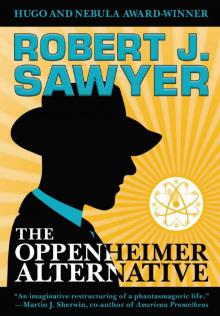 The Oppenheimer Alternative
The Oppenheimer Alternative Factoring Humanity
Factoring Humanity The Shoulders of Giants
The Shoulders of Giants Stream of Consciousness
Stream of Consciousness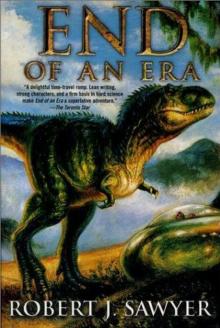 End of an Era
End of an Era The Terminal Experiment
The Terminal Experiment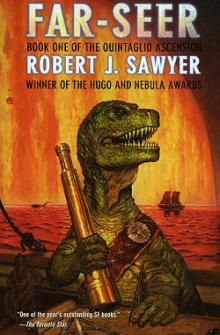 Far-Seer
Far-Seer Mindscan
Mindscan You See But You Do Not Observe
You See But You Do Not Observe Star Light, Star Bright
Star Light, Star Bright Wonder
Wonder Wiping Out
Wiping Out Flashforward
Flashforward Above It All
Above It All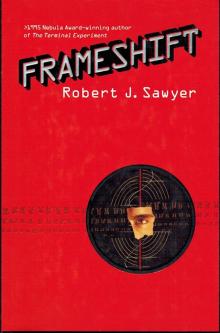 Frameshift
Frameshift The Neanderthal Parallax, Book One - Hominids
The Neanderthal Parallax, Book One - Hominids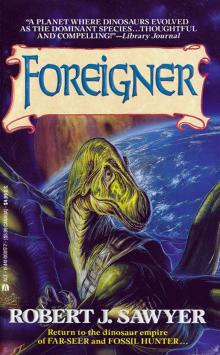 Foreigner
Foreigner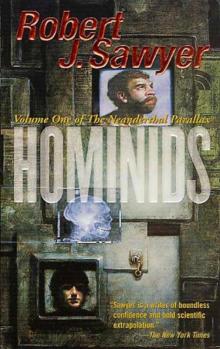 Neanderthal Parallax 1 - Hominids
Neanderthal Parallax 1 - Hominids Relativity
Relativity Identity Theft
Identity Theft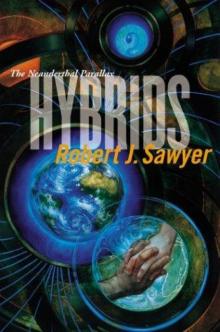 Hybrids np-3
Hybrids np-3 Foreigner qa-3
Foreigner qa-3 WWW: Watch
WWW: Watch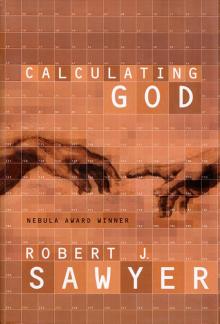 Calculating God
Calculating God The Terminal Experiment (v5)
The Terminal Experiment (v5) Peking Man
Peking Man The Hand You're Dealt
The Hand You're Dealt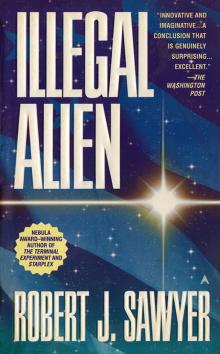 Illegal Alien
Illegal Alien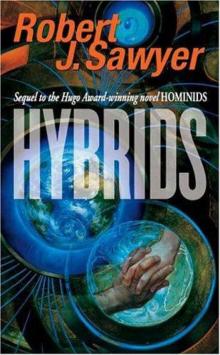 Neanderthal Parallax 3 - Hybrids
Neanderthal Parallax 3 - Hybrids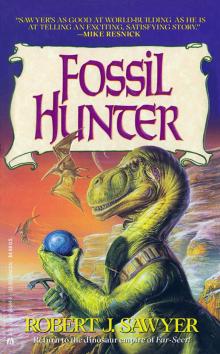 Fossil Hunter
Fossil Hunter WWW: Wonder
WWW: Wonder Iterations
Iterations Red Planet Blues
Red Planet Blues Rollback
Rollback Watch w-2
Watch w-2 Gator
Gator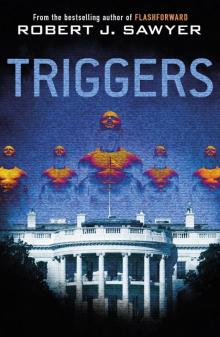 Triggers
Triggers Neanderthal Parallax 2 - Humans
Neanderthal Parallax 2 - Humans Wonder w-3
Wonder w-3 Wake
Wake Just Like Old Times
Just Like Old Times Wake w-1
Wake w-1 Fallen Angel
Fallen Angel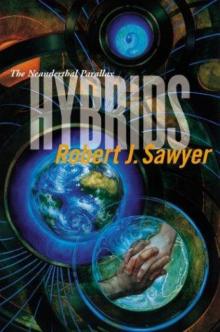 Hybrids
Hybrids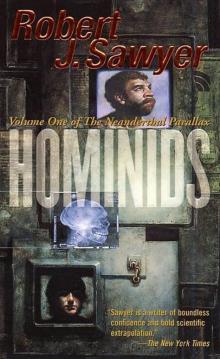 Hominids tnp-1
Hominids tnp-1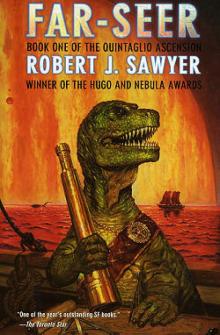 Far-Seer qa-1
Far-Seer qa-1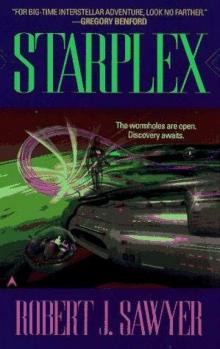 Starplex
Starplex Hominids
Hominids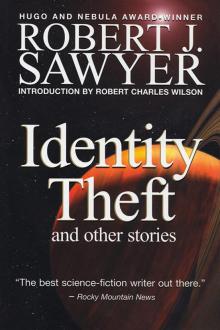 Identity Theft and Other Stories
Identity Theft and Other Stories Watch
Watch Golden Fleece
Golden Fleece Quantum Night
Quantum Night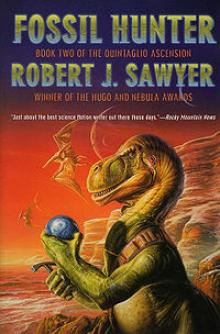 Fossil Hunter qa-2
Fossil Hunter qa-2 Humans np-2
Humans np-2 Biding Time
Biding Time